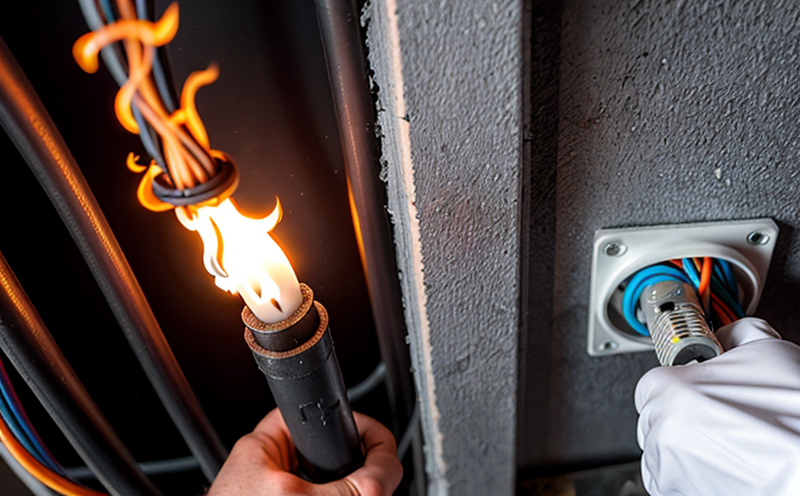EN 50266-2-4 Fire Performance of Electric Cables
The EN 50266-2-4 standard specifies the method for determining the fire performance of electric cables under specified test conditions. This European Standard ensures that electrical cables, especially those used in critical infrastructure such as buildings, power stations, and industrial facilities, can withstand exposure to fire without compromising safety or functionality.
Testing per this standard is essential for ensuring compliance with international regulations aimed at enhancing public safety by reducing the risk of fire-related incidents. The test simulates real-world conditions where electrical cables may be exposed to flames during a fire event. Compliance with EN 50266-2-4 not only ensures product safety but also contributes significantly to the overall fire safety measures in various industries.
The testing procedure involves subjecting electric cables to controlled flame exposure for a specified duration. The test apparatus includes an electrically heated flame and a calorimeter to measure heat release rate. Specimens are tested both vertically hung and horizontally laid, simulating typical installation methods. After the exposure period, the extent of damage is assessed based on visual inspection, weight loss, and structural integrity.
The acceptance criteria for this test are stringent, with clear definitions regarding what constitutes acceptable performance under fire conditions. Cable specimens that pass the test must retain their electrical continuity and mechanical strength to a satisfactory level after being exposed to flames. This ensures that even in case of a fire, the cable can continue performing its intended function, thereby minimizing potential hazards.
Fire resistance testing is crucial for various sectors including construction, energy, transportation, and manufacturing. In buildings, it helps prevent the spread of fires by containing them within their origin point, thus protecting lives and property. For power stations and industrial facilities, passing this test ensures continuous operation even during emergencies, maintaining critical services.
The results from EN 50266-2-4 testing are used in quality management to ensure product reliability and compliance with regulatory requirements. Compliance officers rely on these tests to meet legal obligations and avoid penalties for non-compliance. R&D engineers use the outcomes of this test to improve cable designs and materials, while procurement teams leverage it to select suppliers who adhere to strict fire safety standards.
The testing procedure is conducted in a controlled environment that closely mimics real-world scenarios. The specimen preparation involves cutting cables into standard lengths and securing them according to specified methods before exposing them to the flame source. Post-test analysis includes detailed documentation of any changes observed, which guides further improvements in product design.
A table summarizing key aspects of EN 50266-2-4 is provided below:
| Aspect | Description |
|---|---|
| Test Specimen Type | Electric cables used in various applications. |
| Flame Exposure Duration | Duration varies based on cable type and application. |
| Calorimeter Reading | Measures heat release rate during the exposure period. |
| Acceptance Criteria | Cables must maintain electrical continuity and mechanical strength post-exposure. |
This testing method is critical in ensuring that electric cables can perform reliably under fire conditions. By adhering to this standard, manufacturers not only enhance their product's safety but also contribute to a safer built environment for all stakeholders involved.
Industry Applications
Cables and wiring systems are critical components in various sectors where fire resistance is paramount. Here are some key applications:
- BUILDING CONSTRUCTION: Ensuring that electrical installations within buildings can withstand fires to prevent catastrophic failures.
- POWER STATIONS: Maintaining continuous power supply during emergencies by ensuring cables do not fail under fire conditions.
- INDUSTRIAL FACILITIES: Protecting critical equipment and preventing the spread of fires that could disrupt operations.
- MARINE ENVIRONMENTS: Ensuring safety on ships and offshore platforms where electrical systems are exposed to harsh environmental conditions, including potential fire hazards.
The importance of fire resistance testing cannot be overstated in these environments. It ensures not only the functionality but also the safety of infrastructure that is integral to modern society.
Why Choose This Test
- Comprehensive Evaluation: Tests the entire fire performance, including electrical continuity and mechanical integrity.
- Regulatory Compliance: Ensures adherence to international standards like EN 50266-2-4.
- Informed Decision-Making: Provides detailed data for quality management and product development.
- Risk Reduction: Minimizes risks associated with fire hazards in critical infrastructure.
- Confidence Building: Builds trust among stakeholders by demonstrating adherence to high safety standards.
The rigorous nature of this test ensures that only the highest quality cables and wiring systems are used, thereby enhancing overall safety in various sectors.
Customer Impact and Satisfaction
Compliance with EN 50266-2-4 offers numerous benefits to customers:
- Better Quality Products: Ensures that all cables meet the highest safety standards.
- Enhanced Reputation: Builds a strong reputation for reliability and quality among stakeholders.
- Cost Efficiency: Reduces long-term costs by minimizing risks associated with fire incidents.
- Compliance Assurance: Ensures that products meet all necessary regulatory requirements, avoiding costly non-compliance issues.
The satisfaction of customers is directly linked to the quality and safety of the cables they use. By adhering to this standard, manufacturers can offer products that are trusted and relied upon in critical applications.





